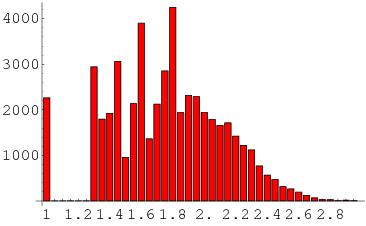


 تاريخ الرياضيات
تاريخ الرياضيات
 الرياضيات في الحضارات المختلفة
الرياضيات في الحضارات المختلفة 
 الرياضيات المتقطعة
الرياضيات المتقطعة
 الجبر
الجبر
 الهندسة
الهندسة 
 المعادلات التفاضلية و التكاملية
المعادلات التفاضلية و التكاملية 
 التحليل
التحليل
 علماء الرياضيات
علماء الرياضيات |
Read More
Date: 21-1-2021
Date: 27-9-2020
Date: 8-11-2020
|

An unsolved problem in mathematics attributed to Lehmer (1933) that concerns the minimum Mahler measure  for a univariate polynomial
for a univariate polynomial  that is not a product of cyclotomic polynomials. Lehmer (1933) conjectured that if
that is not a product of cyclotomic polynomials. Lehmer (1933) conjectured that if  is such an integer polynomial, then
is such an integer polynomial, then
 |
 |
 |
(1) |
 |
 |
 |
(2) |
where  , denoted
, denoted  by Lehmer (1933) and
by Lehmer (1933) and  by Hironaka (2009), is the largest positive root of this polynomial. The roots of this polynomial, plotted in the left figure above, are very special, since 8 of the 10 lie on the unit circle in the complex plane. The roots of the polynomials (represented by half their coefficients) giving the two next smallest known Mahler measures are also illustrated above (Mossinghoff 1998, p. S11).
by Hironaka (2009), is the largest positive root of this polynomial. The roots of this polynomial, plotted in the left figure above, are very special, since 8 of the 10 lie on the unit circle in the complex plane. The roots of the polynomials (represented by half their coefficients) giving the two next smallest known Mahler measures are also illustrated above (Mossinghoff 1998, p. S11).
The best current bound is that of Smyth (1971), who showed that  , where
, where  is a nonzero nonreciprocal polynomial that is not a product of cyclotomic polynomials (Everest 1999), and
is a nonzero nonreciprocal polynomial that is not a product of cyclotomic polynomials (Everest 1999), and  is the real root of
is the real root of  . Generalizations of Smyth's result have been constructed by Lloyd-Smith (1985) and Dubickas (1997).
. Generalizations of Smyth's result have been constructed by Lloyd-Smith (1985) and Dubickas (1997).

In general, the smallest Mahler measures occur for integer polynomials that are small in absolute value. The histogram above shows the distribution of measures for random  -polynomials of random orders 1 to 10. Mossinghoff (1998) gives a table of the smallest known Mahler measures for polynomial degrees up to
-polynomials of random orders 1 to 10. Mossinghoff (1998) gives a table of the smallest known Mahler measures for polynomial degrees up to  , and subsequently demonstrated that
, and subsequently demonstrated that  is the smallest Mahler measure greater than 1 for all degrees up to 40 (Mossinghoff, Hironaka 2009).
is the smallest Mahler measure greater than 1 for all degrees up to 40 (Mossinghoff, Hironaka 2009).
 is a Salem constant.
is a Salem constant.
REFERENCES:
Bailey, D. H. and Broadhurst, D. J. "A Seventeenth-Order Polylogarithm Ladder." 20 Jun 1999. http://arxiv.org/abs/math.CA/9906134.
Boyd, D. W. "Reciprocal Polynomials Having Small Measure." Math. Comput. 35, 1361-1377, 1980.
Boyd, D. W. "Reciprocal Polynomials Having Small Measure. II." Math. Comput. 53, 355-357 and S1-S5, 1989.
Dubickas, A. "Algebraic Conjugates Outside the Unit Circle." In New Trends in Probability and Statistics, Vol. 4: Analytic and Probabilistic Methods in Number Theory. Proceedings of the 2nd International Conference held in Honor of J. Kubilius on His 75th Birthday in Palanga, September 23-27, 1996 (Ed. A. Laurinčikas, E. Manstavičius, and V. Stakenas). Utrecht, Netherlands: VSP, pp. 11-21, 1997.
Everest, G. and Ward, T. Ch. 1 in Heights of Polynomials and Entropy in Algebraic Dynamics. London: Springer-Verlag, 1999.
Hironaka, E. "What Is... Lehmer's Number." Not. Amer. Math. Soc. 56, 374-375, 2009.
Lehmer, D. H. "Factorization of Certain Cyclotomic Functions." Ann. Math. 34, 461-469, 1933.
Lloyd-Smith, C. W. "Algebraic Numbers Near the Unit Circle." Acta Arith. 45, 43-57, 1985.
Mossinghoff, M. "Lehmer's Problem." http://oldweb.cecm.sfu.ca/~mjm/Lehmer/.
Mossinghoff, M. J. "Polynomials with Small Mahler Measure." Math. Comput. 67, 1697-1705 and S11-S14, 1998.
Smyth, C. J. "On the Product of the Conjugates Outside the Unit Circle of an Algebraic Integer." Bull. London Math. Soc. 3, 169-175, 1971.



|
|
|
|
التوتر والسرطان.. علماء يحذرون من "صلة خطيرة"
|
|
|
|
|
|
|
مرآة السيارة: مدى دقة عكسها للصورة الصحيحة
|
|
|
|
|
|
|
نحو شراكة وطنية متكاملة.. الأمين العام للعتبة الحسينية يبحث مع وكيل وزارة الخارجية آفاق التعاون المؤسسي
|
|
|